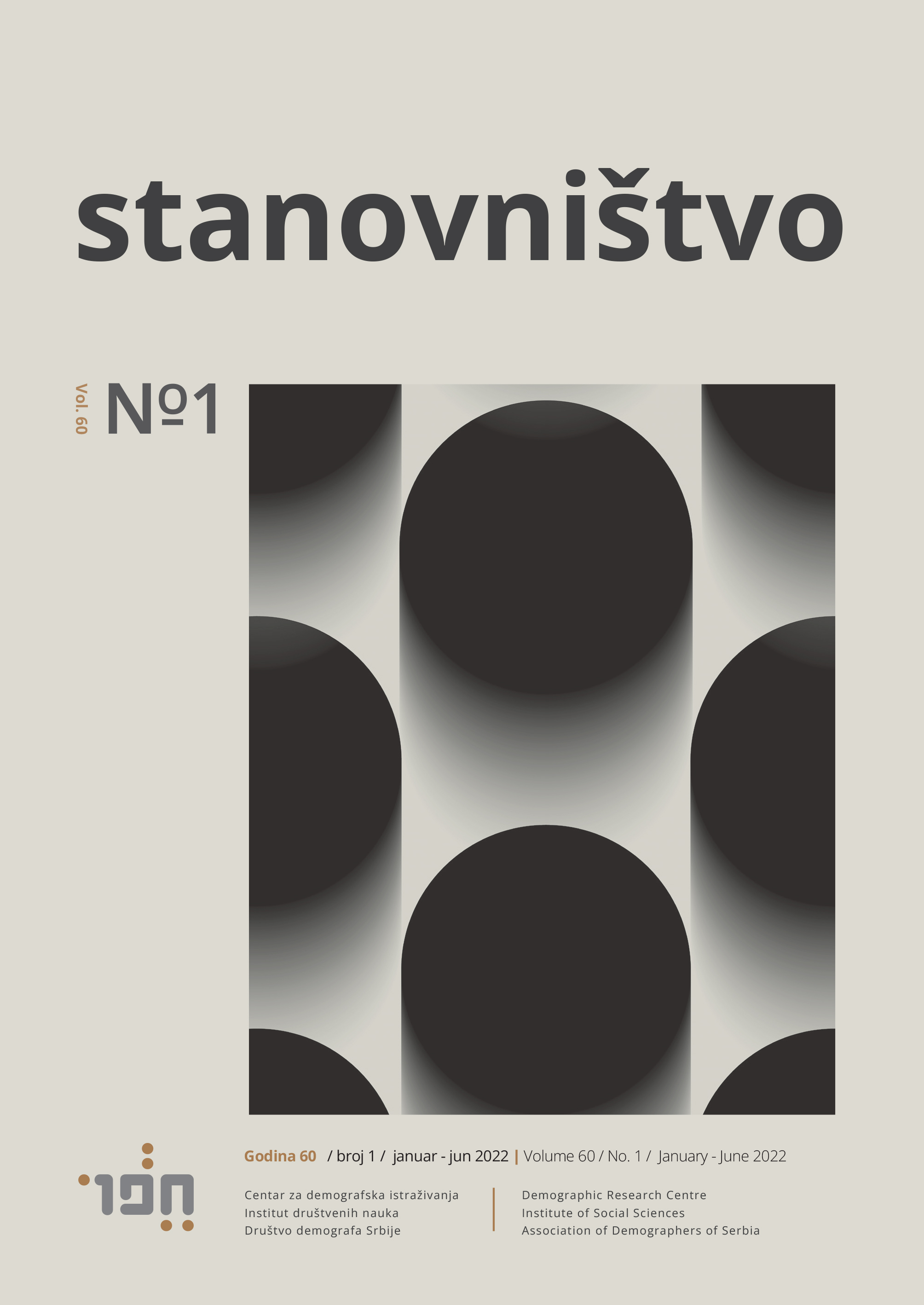The effect of avoidable mortality on life expectancy in Serbia, 2010-2019
Main Article Content
Abstract
Downloads
Article Details

This work is licensed under a Creative Commons Attribution-NonCommercial 4.0 International License.
Published by the Institute of Social Sciences - Center for Demographic Research
References
Andreev, E. M., Nolte, E., Shkolnikov, V. M., Varavikova, E., & McKee, M. (2003). The evolving pattern of avoidable mortality in Russia. International Journal of Epidemiology. https://doi.org/10.1093/ije/dyg085
Arriaga, E. E. (1984). Measuring and explaining the change in life expectancies. Demography, 21(1), 83–96. http://www.jstor.org/stable/2061029
Bahk, J., & Jung-Choi, K. (2020). The Contribution of Avoidable Mortality to the Life Expectancy Gains in Korea between 1998 and 2017. International Journal of Environmental Research and Public Health, 17(18), 6499. https://doi.org/10.3390/ijerph17186499
Dávila-Cervantes, C., & Agudelo-Botero, M. (2018). Changes in life expectancy due to avoidable and non-avoidable deaths in Argentina, Chile, Colombia and Mexico, 2000-2011. Cadernos de Saúde Pública, 34(6). https://doi.org/10.1590/0102-311x00093417
Dicker, D., Nguyen, G., Abate, D., Abate, K. H., Abay, S. M., Abbafati, C., … Murray, C. J. L. (2018). Global, regional, and national age-sex-specific mortality and life expectancy, 1950–2017: A systematic analysis for the Global Burden of Disease Study 2017. The Lancet, 392 (10159), 1684–1735. https://doi.org/10.1016/S0140-6736(18)31891-9
Eun, S. J. (2019). Avoidable, amenable, and preventable mortalities in South Korea, 2000–2017: Age-period-cohort trends and impact on life expectancy at birth. Social Science & Medicine, 237, 112482. https://doi.org/10.1016/j.socscimed.2019.112482
Eurostat (2020). Statistical office of the European Union. https://ec.europa.eu/eurostat/statistics-explained/index.php/Preventable_and_treatable_mortality_statistics
Gispert, R., Serra, I., Bares, M. A., Puig, X., Puigdefabregas, A., & Freitas, A. (2008). The impact of avoidable mortality on life expectancy at birth in Spain: changes between three periods, from 1987 to 2001. Journal of Epidemiology & Community Health, 62(9), 783–789. https://doi.org/10.1136/jech.2007.066027
Grabauskas, V., Gaižauskienė A., Sauliūnė S., & Mišeikytė, R. (2011). Trends in avoidable mortality in Lithuania during 2001-2008 and their impact on life expectancy. Medicina (Kaunas). 47(9), 504–511. PMID: 22156602.
Kiadaliri, A. (2021). Avoidable deaths in Sweden, 1997–2018: temporal trend and the contribution to the gender gap in life expectancy. BMC Public Health 21, 519. https://doi.org/10.1186/s12889-021-10567-5
Mackenbach, J. P., Bouvier-Colle, M. H., & Jougla, E. (1990). Avoidable Mortality and Health Services: A Review of Aggregate Data Studies. Journal of Epidemiology and Community Health 44 (2): 106–111. https://doi.org/10.1136/jech.44.2.106.
Marinković, I. (2017). Pušenje kao osnovni faktor preventabilne smrtnosti u Srbiji. Stanovništvo, LV, No 1/2017, pp 87–106. https://doi.org/10.2298/STNV170610001M
Marinković, I. (2021). Demografska analiza uticaja zdravstvene zaštite i javnog zdravlja na trendove smrtnosti stanovništva Srbije, Institut društvenih nauka, Beograd. ISBN 978-86-7093-241-8
Marinković, I., & Radivojević, B. (2016). Mortality trends and depopulation in Serbia. Geographica Pannonica, 20(4), 220–226. https://doi.org/10.18421/GP20.04-04
Mourgova, M. (2016). The Impact of Avoidable Mortality on the Life Expectancy in Bulgarian Population. European Journal of Interdisciplinary Studies, 2(2), 213–217. https://doi.org/10.26417/ejis.v2i2.p279-283
Mühlichen, M. (2019). Avoidable Mortality in the German Baltic Sea Region Since Reunification: Convergence or Persistent Disparities? European Journal of Population, 35(3), 609–637. https://doi.org/10.1007/s10680-018-9496-y
Nolte, E., & McKee, C. M. (2008). Measuring the health of nations: Updating an earlier analysis. Health Affairs, 27(1), 58–71. https://doi.org/10.1377/hlthaff.27.1.58
Nolte, E., & McKee, M. (2003). Measuring the health of nations: Analysis of mortality amenable to health care. British Medical Journal, 327(7424), 1129–1132. https://doi.org/10.1136/bmj.327.7424.1129
Nolte, E., & McKee, M. (2004). Does Health Care Save Lives? Avoidable Mortality Revisited. Analysis. Nuffield Trust, London, UK., ISBN: 1902089944, 139 pp. https://www.nuffieldtrust.org.uk/research/does-healthcare-save-lives-avoidable-mortality-revisited
Nolte, E., Scholz, R., Shkolnikov, V., & McKee, M. (2002). The contribution of medical care to changing life expectancy in Germany and Poland. Social Science and Medicine, 55(11), 1905–1921. https://doi.org/10.1016/S0277-9536(01)00320-3
ONS (2018). Office for National Statistics – ONS. https://www.ons.gov.uk/peoplepopulationandcommunity/healthandsocialcare/causesofdeath/bulletins/avoidablemortalityinenglandandwales/previousReleases
Page, A., Tobias, M., Glover, J., Wright, C., Hetzel, D., & Fisher, E. (2006). Australian and New Zealand Atlas of Avoidable Mortality. Phidu. Retrieved from http://www.publichealth.gov.au/pdf/atlases/avoid_mortality_aust_2006/avoid_mortality_ch1_intro.pdf
Preston, S. H., Heuveline, P., & Guillot, M. (2001). Demography – Measuring and modeling population processes. New Jersey: Wiley-Blackwell.
Rutstein, D. D., Berenberg, W., Chalmers, T. C., Child, C. G., Fishman, A. P., ... Perrin, E. B. (1976). Measuring the Quality of Medical Care: A Clinical Method. New England Journal of Medicine, 294(11), 582–588. https://doi.org/10.1056/NEJM197603112941104
Subedi, R., Greenberg, T. L., & Roshanafshar, S. (2019). Does geography matter in mortality? An analysis of potentially avoidable mortality by remoteness index in Canada. Health Reports, 30(5), 3–15. https://doi.org/10.25318/82-003-x201900500001-eng
Tobias, M., & Yeh, L.-C. (2009). How much does health care contribute to health gain and to health inequality? Trends in amenable mortality in New Zealand 1981-2004. Australian and New Zealand Journal of Public Health, 33(1), 70–78. https://doi.org/10.1111/j.1753-6405.2009.00342.x
Wojtyniak, B., & Stokwiszewski, J. (2020). Contribution of avoidable causes of death to premature mortality in Poland and selected European countries. Studia Demograficzne, 2(178), 11–34. https://doi.org/10.33119/SD.2020.2.4





